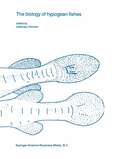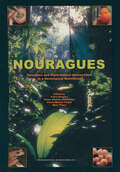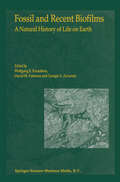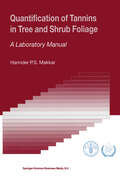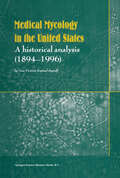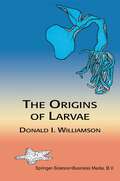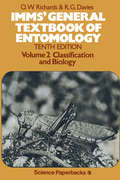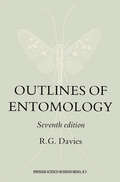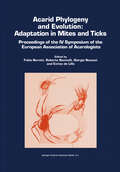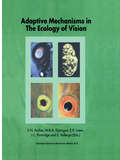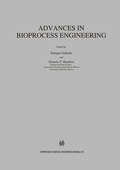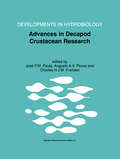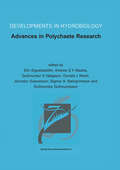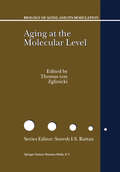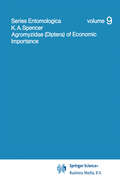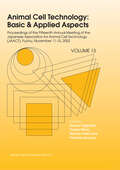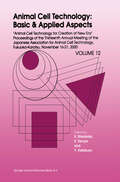- Table View
- List View
Straminipilous Fungi: Systematics of the Peronosporomycetes Including Accounts of the Marine Straminipilous Protists, the Plasmodiophorids and Similar Organisms
by M.W. DickRecombinant Protein Production with Prokaryotic and Eukaryotic Cells. A Comparative View on Host Physiology: Selected articles from the Meeting of the EFB Section on Microbial Physiology, Semmering, Austria, 5th–8th October 2000
by Otto-Wilhelm Merten D. Mattanovich C Lang G. Larsson P. Neubauer D. Porro P. Postma J. Teixeira De Mattos J. A. ColeMore then 20 years have passed now since the first recombinant protein producing microorganisms have been developed. In the meanwhile, numerous proteins have been produced in bacteria, yeasts and filamentous fungi, as weIl as higher eukaryotic cells, and even entire plants and animals. Many recombinant proteins are on the market today, and some of them reached substantial market volumes. On the first sight one would expect the technology - including the physiology of the host strains - to be optimised in detail after a 20 year's period of development. However, several constraints have limited the incentive for optimisation, especially in the pharmaceutical industry like the urge to proceed quickly or the requirement to define the production parameters for registration early in the development phase. The additional expenses for registration of a new production strain often prohibits a change to an optimised strain. A continuous optimisation of the entire production process is not feasible for the same reasons.
The biology of hypogean fishes (Developments in Environmental Biology of Fishes #21)
by Aldemaro RomeroHypogean (cave, artesian) fishes have fascinated researchers even before they were described in the scientific literature in 1842. Since then, a number of scientists have used them to justify their own evolutionary ideas, from neo-Lamarckism to neo-Darwinism, from neutral evolution to selectionist approaches. Research in recent years has shown that these fishes are much more complex in their adaptations to the subterranean environment than previously believed: there are those with features expected from living in total darkness (complete blindness and depigmentation) and poor in nutrients (extremely low metabolic rates); others differ very little, if any, from their epigean (surface) ancestors in their morphology and physiology (but not so in their behavior). Some of them even live in nutrient-rich environments. Actually, one of the most overlooked facets of these animals is that there are more species of hypogean fishes without troglomorphisms (blindness, depigmentation) than with troglomorphic ones. The study of these apparently `unadapted' fishes is providing new insights into our understanding of the evolution of phenotypic characters, founding effect, behavioral, and physiological adaptations. The 86 species of troglomorphic fishes described so far belong to 18 different families, many of which would hardly fit the notion that they were 'preadapted' to conquer the underground environment. Further, many troglomorphic `species' show very little genotypic differentiation when compared with their putative ancestors, indicating that massive phenotype changes can be achieved via little genetic reorganization, a reorganization that mostly affects regulatory genes. These and many other topics are discussed in this volume containing 29 papers, written by 41 authors from 9 countries. Hopefully, this volume will convince many other researchers that hypogean fishes represent a unique opportunity to study a concept in evolutionary biology that is only superficially understood: convergent evolution.
Nouragues: Dynamics and Plant-Animal Interactions in a Neotropical Rainforest (Monographiae Biologicae #80)
by F. Bongers P. Charles-Dominique P. M. Forget Marc ThéryNouragues is a tropical forest research station in French Guiana. It was established in 1986 for research on natural mechanisms of forest regeneration. Since then a lot of research has been done on this and related topics. This book provides an overview of the main research results, and focuses on plant communities, vertebrate communities and evolutionary ecology, frugivory and seed dispersal, and forest dynamics and recruitment. The appendices give (annoted) checklists of plants, birds, mammals, herpetofauna and fishes found in the same area.
One Hundred Years of Chromosome Research and What Remains to be Learned
by A. Lima-de-FariaOne Hundred Years of Chromosome Research: What Remains to be Learned, offers the reader a critical analysis of the observations and experiments that shaped the last 100 years of chromosome research, as well as the ideas which prevailed during this period. Emphasis is placed on what remains to be learned, particularly in light of reality of the sequencing of DNA which leaves the previous era of chromosome research as a prehistoric event. It is at this turning point, that well formulated questions can be asked about many of the chromosome's properties, which remain to be unveiled. The author, Lima-de-Faria is Professor Emeritus of Molecular Cytogenetics at Lund Unviersity, Sweden, previously Head of the Institute of Molecular Cytogenetics, Lund University.
Seed Dispersal by Ants in a Deciduous Forest Ecosystem: Mechanisms, Strategies, Adaptations
by Elena Gorb Stanislav S. GorbCountless ants transport and deposit seeds and thereby influence the survival, death, and evolution of many plant species. In higher plants, seed dispersal by ants (myrmecochory) has appeared many times independently in different lineages. More than 3000 plant species are known to utilize ant assistance to be planted. Myrmecochory is a very interesting and rather enigmatic form of mutualistic ant-plant associations. This phenomenon is extremely complex, because there are hundreds of ant species connected with hundreds of plant species. This book effectively combines a thorough approach to investigating morphological and physiological adaptations of plants with elegant field experiments on the behaviour of ants. This monograph is a first attempt at collecting information about morphology, ecology and phenology of ants and plants from one ecosystem. The book gives readers a panoramic view of the hidden, poorly-known interrelations not only between pairs of ants and plant species, but also between species communities in the ecosystem. The authors have considered not just one aspect of animal-plant relationships, but have tried to show them in all their complexity. Some aspects of the ant-plant interactions described in the book may be of interest to botanists, others to zoologists or ecologists, but the entire work is an excellent example of the marriage of these biological disciplines.
Fossil and Recent Biofilms: A Natural History of Life on Earth
by W. E. Krumbein D. M. Paterson G. A. ZavarzinMICROBIAL BIOFILMS: PROTECTIVE NICHES IN ANCIENT AND MODERN GEOMICROBIOLOGY J. W. Costerton and Paul Stoodley Center for Biofilm Engineering Montana State University As this book is published based on discussions of a conference that was held in 2001, it may be useful to provide an update on the most recent revelations about biofilms, so that this excellent exposition of the contribution of microbial biofilms to geological processes may be placed in a modem context. The importance of the contribution of microbial biofilms to global processes is only now being appreciated as it is revealed that all terrestrial surfaces are teeming with microbial life in the form of biofilm communities. These communities live on soil particles, in rock fissures, marine and river sediments and at the very extremes of terrestrial habitats from inside Antarctic ice to the walls of deep sea hydrothermal vents. The contribution of these biofilm communities generally went unrecognized because it was the water that was where microbiologists looked for life, not the surfaces, although, evidence of the early association of microbes with surfaces was in fact present in the fossil record (Rasmussen, 2000; Reysenbach, and Cady, 2001). It is also revealing that biofilm formation is found in prokaryotes from the most deeply rooted branches of the phylogenetic tree in both the Archaea and Bacteria kingdoms, the Korarchaeota and Aquificales respectively (Jahnke et al. 2001; Reysenbach et al. 2000).
Quantification of Tannins in Tree and Shrub Foliage: A Laboratory Manual
by Harinder P.S. MakkarHere is the most complete guide available for the analysis of tannins. A battery of tannin methodologies is presented in a simple, clear and easy-to-understand manner. This unique guide covers chemical, biological and radio isotopic tannin assays. Comprehensive step-by-step protocols are presented for each method. The protocols enable non-specialists and specialists alike to implement the methods easily in the laboratory. It is an ideal laboratory manual for research scientists, graduate students, and laboratory personnel working in the fields of animal nutrition, soil nutrient management, wild life-plant interactions, and plant breeding.
Medical Mycology in the United States: A Historical Analysis (1894–1996)
by Ana Victoria Espinell-IngroffThe Origins of Larvae
by D. WilliamsonMany biological facts are irreconcilable with the assumption that larvae and adults evolved from the same genetic stock. The author of this book draws attention to these, and presents his alternative hypothesis that larvae have been transferred from one taxon to another.In his previous book (Larvae and Evolution, 1992), the author used larval transfer to explain developmental anomalies in eight animal phyla. In the present book, he claims that the basic forms of all larvae and all embryos have been transferred from foreign taxa. This leads to a new, comprehensive theory on the origin of embryos and larvae, replacing the discredited 'recapitulation' theory of Haeckel (1866). Metamorphosis, previously unexplained, represents a change in taxon during development.
Aquatic Mites from Genes to Communities
by Heather C. ProctorAlthough the ancestral home of chelicerates was the sea, the vast majority of modern species live on land. Most students of spiders and mites also restrict themselves to terrestrial habitats. However, a surprising number of mites (Arachnida: Acari) have returned to a watery existence. Approximately 7000 species from the Mesostigmata, Astigmata, Oribatida, and especially the Prostigmata, now live in marine and freshwater habitats. In Aquatic Mites, a dozen chapters explore the distribution, ecology, behavior, genetics, and evolution of the most diverse of these astonishing arachnids. The results of these studies raise as many interesting questions as they answer, and should provoke more investigations of the biology of freshwater and marine Acari.
Imms’ General Textbook of Entomology: Volume 2: Classification and Biology
by O.W. Richards R.G. Daviesseem as appropriate now as the original balance was when Dr A. D. Imms' textbook was first published over fifty years ago. There are 35 new figures, all based on published illustrations, the sources of which are acknowledged in the captions. We are grateful to the authors concerned and also to Miss K. Priest of Messrs Chapman & Hall, who saved us from many errors and omissions, and to Mrs R. G. Davies for substantial help in preparing the bibliographies and checking references. London O. W. R. R. G. D. May 1976 Part III THEORDERSOFINSECTS THE CLASSIFICATION AND PHYLOGENY OF INSECTS The classification of insects has passed through many changes and with the growth of detailed knowledge an increasing number of orders has come to be recognized. Handlirsch (1908) and Wilson and Doner (1937) have reviewed the earlier attempts at classification, among which the schemes of Brauer (1885), Sharp (1899) and Borner (1904) did much to define the more distinctive recent orders. In 1908 Handlirsch published a more revolutionary system, incorporating recent and fossil forms, which gave the Collembola, Thysanura and Diplura the status of three independent Arthropodan classes and considered as separate orders such groups as the Sialoidea, Raphidioidea, Heteroptera and Homoptera. He also split up the old order Orthoptera, gave its components ordinal rank and regrouped them with some of the other orders into a subclass Orthopteroidea and another subclass Blattaeformia.
Outlines of Entomology
by R. G. DaviesThe present edition may be regarded as a descendant, much changed and greatly enlarged, of the late Dr A. D. Imms' Outlines of Entomology, first published in 1942. This went through three further editions without much change, but after the death of the original author a fifth, revised edition by Professor o. W. Richards and myself appeared in 1959 and a sixth in 1978. The book now appears in a considerably extended version in which I have tried to provide a more balanced introduction to the whole field of modern entomology by dealing with several aspects of the subject not discussed at all in previous editions. Thus, in addition to innumerable lesser changes in the sections on insect structure, function, development, classification and phylogeny, I have completely recast the earlier chapter on some important modes of life in insects. This now includes a far wider range of biological topic;s well exemplified by the insects and should, I hope, appeal not only to, those already dedicated to entomology but also to others with more general biological interests. A completely new chapter on the biology of insect populations has also been added and may serve to indicate the debt which modern ecological theory owes to work on insect populations. It should hardly be necessary to apologize for introducing a certain amount of elementary mathematics into this account of a subject which is now among the most highly quantitative of biological disciplines.
Acarid Phylogeny and Evolution: Proceedings of the IV Symposium of the European Association of Acarologists
by Fabio Bernini Roberto Nannelli Giorgio Nuzzaci Enrico De LilloThe words pronounced by Serge Kreiter during the meeting come to mind. They could record exactly the situation of Acarology in Europe and in the World: "I think that in many European countries there are very few full time acarologists. It is very rare to have new positions available . . . . And public money, from the European Community but also from national countries, is very hard to get when you want to work on mites . . . . Could two acarological associations in Europe (Eur. A. Ac. and S. I. A. L. F) work together or, better, get married?" So, the fourth symposium of the European Acarologists has not only been the occasion to have an idea on which direction the research is addressed today, but also it pointed out the difficulties of our "scientific hranch". On the basis of the presentations and invited papers we had evidences of a "new" Acarology based on modern techniques and methods of investigations but also the importance, often sheltered even if of relevant value, of the "old" Acarology made on the alpha taxonomy and basic studies. So, a "new" Acarology needs the "old" one. In this context, the hope to put together the European acarologists has been coming up. This fact, of political meaning, can surely improve the acarological movement and the discussion on this point showed clearly the importance of several other activities and efforts in this direction. We hope that the meeting in Siena will represent a significative stone for the progress of Acarology.
Adaptive Mechanisms in the Ecology of Vision
by S. Archer M. B. Djamgoz E. Loew J. C. Partridge S. VallergaJohn Lythgoe was one of the pioneers of the 'Ecology of Vision', a subject that he ably delineated in his classic and inspirational book published some 20 years ago [1]. At heart, the original book aimed generally to identify inter-relationships between vision, animal behaviour and the environment. John Lythgoe excelled at identifying the interesting 'questions' in the ecology of an animal that fitted the 'answers' presented by an analysis of the visual system. Over the last twenty years, however, since Lythgoe's landmark publication, much progress has been made and the field has broadened considerably. In particular, our understanding of the 'adaptive mechanisms' underlying the ecology of vision has reached considerable depths, extending to the molecular dimension, partly as a result of development and application of new techniques. This complements the advances made in parallel in clinically oriented vision research [2]. The current book endeavours to review the progress made in the ecology of vision field by bringing together many of the major researchers presently active in the expanded subject area. The contents deal with theoretical and physical considerations of light and photoreception, present examples of visual system structure and function, and delve into aspects of visual behaviour and communi cation. Throughout the book, we have tried to emphasise one of the major themes to emerge within the ecology of vision: the high degree of adaptability that visual mechanisms are capable of undergoing in response to diverse, and dynamic, environments and behaviours.
Advances in Bioprocess Engineering
by Enrique Galindo Octavio R. RamírezBioprocess engineering plays a key role in the development and optimization of bioprocesses leading to the products of biotechnology. A survey of the state-of-the-art in this field is greatly needed. This work covers all the essential sub-areas and as such is required reading for scientists active in all the disciplines involved in bioprocess engineering. This review of basic and applied approaches is brought together by a broad international group of expert authors. The work is a reflection of the First International Symposium on Bioprocess Engineering, June 1994. However, it must be emphasized that the book cannot be perceived as a regular symposium proceedings volume: a strict peer-review process assures the readers of a high level of quality; more than a quarter of the work consists of invited contributions, while less than half of the spontaneously submitted manuscripts were accepted for publication. Advances in Bioprocess Engineering belongs among the indispensable set of instruments of today's researcher in this field.
Advances in Decapod Crustacean Research: Proceedings of the 7th Colloquium Crustacea Decapoda Mediterranea, held at the Faculty of Sciences of the University of Lisbon, Portugal, 6–9 September 1999 (Developments in Hydrobiology #154)
by José P.M. Paula, Augusto A.V. Flores & Charles H.J.M. FransenDecapod crustaceans are a particularly important animal group in a variety of aquatic environments, such as freshwater, estuaries, and oceans. Research on this group has increased during recent decades, and relates to their economic and ecological importance. The papers included reflect current trends in decapod crustacean research, and present results on a diversity of specific research fields, grouped into the major themes: a) Systematics, Phylogeny, and Biogeography, b) Growth, Morphology, and Development, c) Ecology and Behaviour, d) Reproduction, and e) Fisheries and Culture. The Colloquia Crustacea Decapoda Mediterranea are devoted to decapod crustacean research, and organised on a 3-year basis by institutions of the Mediterranean geographical area. The scope of these meetings has progressively widened throughout the sequence of events, and presently welcomes contributions from crustacean research world-wide.
Advances in Polychaete Research (Developments in Hydrobiology #170)
by Elin Sigvaldadottir Andrew S. Y. Mackie Gudmundur V. Helgason Donald J. Reish Jorundur Svavarsson Sigmar A. Steingrimsson Gudmundur GudmundssonIn July 2001 experts from all around the world met in Reykjavik, Iceland to discuss various issues of polychaete biology. In particular the latest developments in cladistic inference of polychaete phylogeny were presented. Some studies applied recent molecular techniques, revealing unknown genetic relationships between the different families of polychaetous annelids. This volume is of interest to specialists and students seeking an introduction to the latest developments in the field of systematics and ecology of polychaetous annelids. This book is one in a series presenting results from the International Polychaete conferences.
Aging at the Molecular Level (Biology of Aging and its Modulation #1)
by Thomas Von ZglinickiDuring the last 40 years, the study of the biological basis of aging has progressed tremendously, and it has now become an independent and respectable field of study and research. The essential cause of aging is molecular damage that slowly overwhelms cellular and organismic defense, repair and maintenance systems. In recent years, a wealth of highly sophisticated research has transformed this idea from a credible hypothesis not only to a major theory, but essentially to accepted knowledge. Aging at the Molecular Level examines the key elements in this transformation. Bringing together contributions from an international team of authors, this volume will be of interest to graduates and postgraduates in the fields of medicine and nursing, researchers of different aspects of biogerontology and those in the pharmaceutical, cosmeceutical, nutraceutical and health-care industry.
Aging of Cells in and Outside the Body (Biology of Aging and its Modulation #2)
by S. Kaul Renu WadwhaThis book provides updated knowledge on the basic features and mechanisms of cellular aging established since its first manifestation at cellular level 40 years ago. Contributions of genetic and environmental factors, failure of genetic and cellular repair mechanisms, and the epigenetic modifications determine the final lifespan of cells. This book also provides an understanding on how aging mechanisms in mice, a most frequently used model, differ with that of humans who receive better tumor surveillance because of stringent controls on aging mechanisms. It also appraises the use of modern technology for aging studies and its intervention. This book serves as an excellent reading on cellular aging for undergraduate students, researchers and experts of this area.
Aging of Organisms (Biology of Aging and its Modulation #4)
by H. D. OsiewaczBiological aging as the time-depending general decline of biological systems associated with a progressively increasing mortality risk is a general phenomenom of great significance. The underlying processes are very complex and depending on genetic and environment factors. These factors encode or affect a network of interconnected cellular pathways. In no system this network has been deciphered in greater detail. However, the strategy of studying various biological systems has let to the identification of pathways and specific modules and makes it obvious that aging is the result of different overlapping mechanisms and pathways. Some of these appear to be conserved ("public") among species, others are specific or "private" and only of significance in one or a few organisms. This volume in the series on "Biology of aging and its modulation" specifically focuses on organismic aging. The book covers research on organisms from lower to higher complexity representing examples from very diverse taxa like photosynthetic plants, fungi, sponges, nematodes, flies, birds and mammals. Such a broad treatise of this complex topic provides a comprehensive "flavor" about the current issues dealt with in this rapidly growing scientific discipline.
Aging of the Organs and Systems (Biology of Aging and its Modulation #3)
by Richard AspinallDuring the last 40 years, the study of the biological basis of aging has progressed tremendously, and it has now become an independent and respectable field of study and research. This volume on "Aging of Organs and Systems", is an attempt to bring understanding to both the aging process and the disease processes of old age. Bringing together contributions from an international team of authors, it will be of interest to graduates and postgraduates in the fields of medicine and nursing, researchers of different aspects of biogerontology and those in the pharmaceutical, cosmeceutical, nutriceutical and health-care industry.
Agromyzidae (Series Entomologica #9)
by K.A. SpencerThe original stimulus which started KENNETH SPENCER on a study of the Agro myzid flies was an invitation, which he accepted, to translate from the German the monograph on Leaf Miners by Professor E. M. HERING. From this developed nearly 20 years of collaboration until Professor HERING's death in 1967. Dr. SPENCER has himself described over 600 new species in the family, many of which he collected and reared from known host plants during his extensive travels to all the five main continents. Largely as a result of his work, the number of species known in Britain has increased from 90 in 1945 to 313 today. He is thus uniquely qualified to write this book about the hundred and fifty or so species which are regularly associated with cultivated plants. Much of the taxonomic detail provided here will be of value primarily to specialists; but with the help of a microscope and the botanical host list (Chapter 2) and the numerous illustrations (mostly prepared by ANN SPENCER) those in agri cultural institutes and elsewhere should now be able to identify the majority of species found attacking crops in any part of the world.
Animal Cell Technology: Proceedings of the Fifteenth Annual Meeting of the Japanese Association for Animal Cell Technology (JAACT), Fuchu, Japan, November 11-15, 2002 (Animal Cell Technology: Basic & Applied Aspects #13)
by Kazumi Yagasaki Yutaka Miura Makoto Hatori Yoshihiro NomuraAnimal cell technology is a growing discipline of cell biology which aims not only to understand structures, functions and behaviors of differentiated animal cells, but also to ascertain their abilities to be used in industrial and medical purposes. The goal of animal cell technology includes accomplishments of clonal expansion of differentiated cells with useful ability, optimization of their culture conditions, modulation of their ability for production of medically and pharmaceutically important proteins and the application of animal cells to gene therapy, artificial organs and functional foods. This volume gives the readers a complete review of present state-of-the-art in Japan and other countries where this field is well advanced. The Proceedings will be useful for the cell biologists, biochemists, molecular biologists, immunologists, biochemical engineers and other disciplines related to animal cell culture, working in either academic environments or in industries of biotechnology and pharmacy.
Animal Cell Technology: Proceedings of the Thirteenth Annual Meeting of the Japanese Association for Animal Cell Technology (JAACT), Fukuoka-Karatsu, November 16–21, 2000 (Animal Cell Technology: Basic & Applied Aspects #12)
by Sanetaka Shirahata Kiichiro Teruya Yoshinori KatakuraAnimal cell technology is a growing discipline of cell biology, which aims not only to understand structures, functions, and behaviours of differentiated animal cells but also to ascertain their ability to be used for industrial and medical purposes. The goal of animal cell technology includes accomplishments of clonal expansion of differentiated cells with useful ability, optimisation of their culture conditions, modulation of their ability for production of medically and pharmaceutically important proteins, and the application of animal cells to gene therapy, artificial organs, and functional foods. This volume gives the reader a complete review of the present state of the art in Japan and other countries where this field is well advanced. The Proceedings will be useful for cell biologists, biochemists, molecular biologists, immunologists, biochemical engineers, and other disciplines related to animal cell culture, working in either academic environments or in industries of biotechnology and pharmacy.


